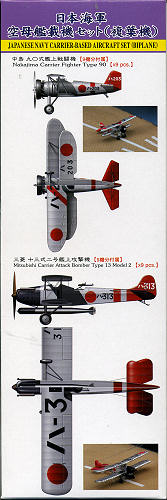 Hasegawa 1/700 Japanese Carrier Based Aircraft Set (Biplane).
Hasegawa 1/700 Japanese Carrier Based Aircraft Set (Biplane). Hasegawa 1/700 Japanese Carrier Based Aircraft Set (Biplane).
Hasegawa 1/700 Japanese Carrier Based Aircraft Set (Biplane).
| KIT #: | 10608 QG 23 |
| PRICE: | 1,000 yen |
| DECALS: | 18 options for each type |
| REVIEWER: | Scott Van Aken |
| NOTES: | For 1/700 Akagi (early version) |
| HISTORY |
Nakajima type 90 fighter
The A2N was developed as a private venture by Nakajima for the Imperial Japanese Navy. It was based loosely on the Boeing Model 69 and Boeing Model 100, examples of both having been imported in 1928 and 1929 respectively. Takao Yoshida led the design team. Two prototypes were ready by December 1929. Powered by Bristol Jupiter VI engines, these were rejected, not being regarded as offering a significant improvement over the Nakajima A1N.
Jingo Kurihara carried out a partial redesign and another prototype, the A2N1, powered by a 432-kW (580-hp) Nakajima Kotobuki 2, was completed in May 1931. The type was adopted by the Navy in April 1932.
A two-seat trainer was later developed from the Type 90 as the A3N1.
Mitsubishi type 13 model 2 attack bomber
While working with the Mitsubishi company, the British aircraft designer Herbert Smith designed the 2MT1 two-seat biplane torpedo bomber which flew for the first time in January 1923. It went into Japanese Navy service as the Type 13-1 carrier-borne attack aircraft or B1M1, and was followed by the 2MT2 and 2MT3 variants (also designated B1M1). The redesigned Type 13-2 was designated B1M2. The final version, the Type 13-3 or B1M3, had the company designation 3MT2 and was a three-seater. Total production was 443. The B1M was powered by a 335kW Napier Lion or Hispano-Suiza engine according to version.
The type entered service in 1924 and served into the 1930s, 32 flying from the aircraft carriers Kaga and Hōshō during the Shanghai Incident in 1932. An aircraft from Kaga was lost during the famous air encounter when American volunteer pilot Robert Short lost his life while flying for the Chinese.
From 1929, a number of surplus B1Ms were converted for civilian use, being fitted with an enclosed cabin for passengers or cargo.
| THE KIT |
 This set includes 9 each of the Type 90 fighter and Type 13 attack bomber. The kit is molded in grey plastic as these planes had little in the way of clear bits. Construction of each type is simple as the only separate parts are the upper wing, landing gear and for the type 13, the torpedo. No wing st
This set includes 9 each of the Type 90 fighter and Type 13 attack bomber. The kit is molded in grey plastic as these planes had little in the way of clear bits. Construction of each type is simple as the only separate parts are the upper wing, landing gear and for the type 13, the torpedo. No wing st ruts on this one, though if you feel the need to add them, I'm sure you could easily stretch some sprue to make what is needed. Same with props. Now I'm betting that some enterprising brass maker or even Hasegawa themselves will be producing these bits.
ruts on this one, though if you feel the need to add them, I'm sure you could easily stretch some sprue to make what is needed. Same with props. Now I'm betting that some enterprising brass maker or even Hasegawa themselves will be producing these bits.
The set also has a very large decal sheet that is the same as what comes with the Akagi kit, though now, when combining this set with the ship kit, you can now use more of the markings and have spares in case you need them. They are quite well printed and provide all that is needed.
| CONCLUSIONS |
So there you have it. Is it an accessory pack or a bunch of very small kits? You decide.
| REFERENCES |
October 2008
My thanks to www.dragonmodelsusa.com for providing the preview set. Get yours at your local shop or on-line store.
If you would like your product reviewed fairly and fairly quickly, please contact the editor or see other details in the
Back to the Previews Index Page